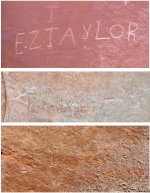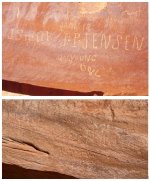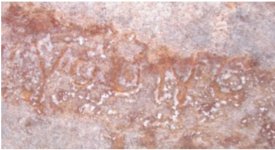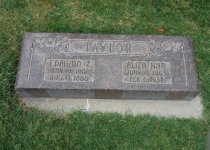JFRCalifornia
Keeper of San Juan Secrets
The rise and fall of Lake Powell has fundamentally changed the landscape over the decades through the power of moving water. The massive siltation above Hite and at the heads of the other major tributaries are the clearest examples. But it's not just deposition but erosion that can take its toll. The destruction of Fort Moki is perhaps the most dramatic illustration of that, discussed at length in other threads here, including this one:
But there are many more subtle examples, and its worth seeking them out. One of these relates to the historic inscriptions at Register Rock, across from Hole in the Rock. Many pioneers of the Mormon San Juan Mission carved their names in January 1880 on the vertical wall near the east side of the river, now known as Register Rock. Until the rise of Lake Powell, these remained as clear as the day they were etched on the wall. In a separate thread, I'll dive more into my recent effort to follow their trail, but for now I just want to focus on showing how those inscriptions have fared over time.
I'm attaching three images of the same inscription taken over a 56-year period to illustrate the changes. I was 6 years old when the first of these were taken in 1969, but I took the other two in 2003 and 2025, and the comparison shows what immersion in water can do. Just to give you a frame of reference, even though Lake Powell began to fill in 1963, the historic inscriptions didn't slide underwater until 1971. When the lake first began to drop to then-historic lows in 2000-04, one upside of that was that the etchings reappeared. I was excited to visit them in August 2003, not long after they again saw the sun. I've been back several times since, most recently about a month ago. Between 2003 and 2025, the lake as gone up and down several times, alternately concealing and re-exposing them like a washing machine. The erosive power of the fluctuating lake has taken its toll.
In January 1880, E.Z. Taylor was a 19-year-old member of the San Juan Mission, which crossed the Colorado River at Hole in the Rock that month, seeking to extend the LDS presence through a new settlement in southeastern Utah--they ultimately founded Bluff. The first image of Taylor's wall signature was taken by Tad Nichols in 1969, and then it was still clearly legible, showing little or any wear even after 82 years. The second image is one I took in August 2003, when Lake Powell receded enough to reveal the inscriptions for the first time since 1971. Although the white contrast in the etching had been lost, each letter of the name was still quite readable. The last image is from August 2025. With multiple rises and falls of the lake since 2003, erosion along the changing shoreline has now obscured many of the letters...

In a recent thread, jayfromtexas pondered an intriguing topic, brought about by the declining lake levels we can expect through 2021. Here's what he wrote:
"Unfortunately, because of the siltation in the White Canyon area I don't believe Fort Moki will be visible anymore. Anyone able to go in there and check it out? From old photos it looks like the ruins aren't that far above the river near the mouth of the canyon. Here is an old photo I found (I believe it may have been the Doc Marston collection at the Huntington Library). From the vantage of this photo, sadly I believe it probably...
"Unfortunately, because of the siltation in the White Canyon area I don't believe Fort Moki will be visible anymore. Anyone able to go in there and check it out? From old photos it looks like the ruins aren't that far above the river near the mouth of the canyon. Here is an old photo I found (I believe it may have been the Doc Marston collection at the Huntington Library). From the vantage of this photo, sadly I believe it probably...
- JFRCalifornia
- Replies: 24
- Forum: Lake Powell Issues
But there are many more subtle examples, and its worth seeking them out. One of these relates to the historic inscriptions at Register Rock, across from Hole in the Rock. Many pioneers of the Mormon San Juan Mission carved their names in January 1880 on the vertical wall near the east side of the river, now known as Register Rock. Until the rise of Lake Powell, these remained as clear as the day they were etched on the wall. In a separate thread, I'll dive more into my recent effort to follow their trail, but for now I just want to focus on showing how those inscriptions have fared over time.
I'm attaching three images of the same inscription taken over a 56-year period to illustrate the changes. I was 6 years old when the first of these were taken in 1969, but I took the other two in 2003 and 2025, and the comparison shows what immersion in water can do. Just to give you a frame of reference, even though Lake Powell began to fill in 1963, the historic inscriptions didn't slide underwater until 1971. When the lake first began to drop to then-historic lows in 2000-04, one upside of that was that the etchings reappeared. I was excited to visit them in August 2003, not long after they again saw the sun. I've been back several times since, most recently about a month ago. Between 2003 and 2025, the lake as gone up and down several times, alternately concealing and re-exposing them like a washing machine. The erosive power of the fluctuating lake has taken its toll.
In January 1880, E.Z. Taylor was a 19-year-old member of the San Juan Mission, which crossed the Colorado River at Hole in the Rock that month, seeking to extend the LDS presence through a new settlement in southeastern Utah--they ultimately founded Bluff. The first image of Taylor's wall signature was taken by Tad Nichols in 1969, and then it was still clearly legible, showing little or any wear even after 82 years. The second image is one I took in August 2003, when Lake Powell receded enough to reveal the inscriptions for the first time since 1971. Although the white contrast in the etching had been lost, each letter of the name was still quite readable. The last image is from August 2025. With multiple rises and falls of the lake since 2003, erosion along the changing shoreline has now obscured many of the letters...

Last edited:



